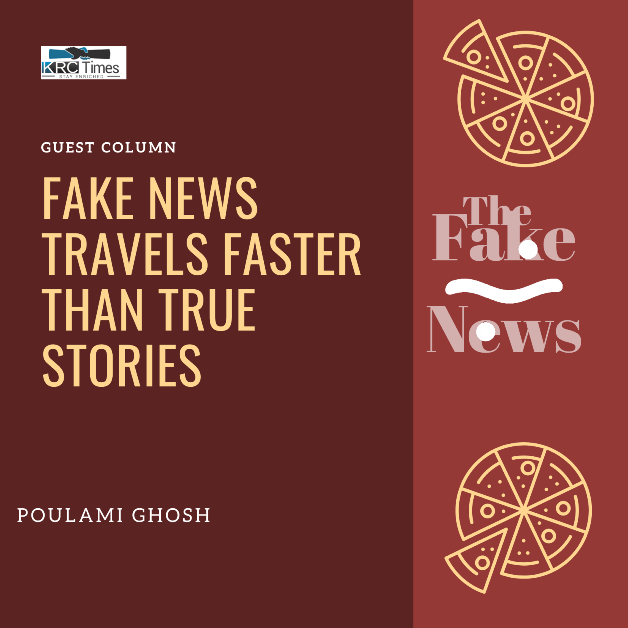India has been simultaneously fighting two viruses; one real and the other being the fake one but equally lethal
 Poulami Ghosh
Poulami Ghosh

Fake news, as a major malaise, is not a recent phenomenon; however, with the advent of social media, the menace has acquired a lethal form. Fake news is stories based on false information and fabricated (with no verifiable facts) sources or quotes. It exists within a larger ecosystem of mis and disinformation.
If we look for the broader spectrum, social media covers all the factors which lead to the rise of fake news be it political or based on ideas. Today, we don’t just consume information from newspapers, television, and radio but from social media platforms like Facebook, Whatsapp, and Twitter. These bags the primary positions for spreading fake news.
With the ever-growing popularity of social media, the amount of fake news surfaced is one of the biggest concerns across the world. India is not alone in who fight against the menace of fake news but the phenomenon of fake news is much more severe because of the country’s rapidly growing social media base and careless regulation of social media platforms.
In the days of COVID-19, fear has gripped people’s life because of raising concerns with regard to the Virus, which are not always based on real facts. As soon as India reported its first COVID-19 case, the country’s social media space suddenly experienced a massive spike in all kinds of information in the form of videos, short interviews, movies, and documentaries on a range of issues related to the pandemic.
Millions of fake messages including catchy and appealing videos promoting the miraculous power of cow urine, or Gaumutra, in curing the disease began to flood the pages on most prominent social media platforms. This has further added to the confusion about Covid-19 management.
While going through an in-depth study of various facets of fake news, one of the interesting factors which emerge is fake news is not restricted to few thousand users on social media. In the case of COVID-19, they have been amplified by leaders in positions of power across the World. For example, US President Donald Trump said injecting people with disinfectants or exposure to sunlight could cure COVID-19. India’s Yoga Guru Ramdev suggested applying mustard oil through the nostrils can be a useful remedy to fight against the pandemic.
Keeping aside the political impact, fake news in India has affected the economy to its core. A rumour that consumption of Chicken could lead to Covid-19 infection spread like a wildfire. It caused massive damage to the poultry industry as many people stopped consuming chicken.
To cut it short, India has been simultaneously fighting two viruses; one real and the other being the fake one but equally lethal. Fake news and misinformation have created numerous hurdles for governments at all levels; Union, the state, and the local, in their fight against the pandemic.

Media plays a pivotal role in the spread of fake news. News channels prefer stories that boost their TRP to ones that are actually relevant. The news provided is mostly biased towards a particular political party. But the story does not end here. To cut it short, India has been simultaneously fighting two viruses; one real and the other being the fake one but equally lethal.
In India, fake news is more dangerous as it leads to polarization and violent crimes, like lynching. As reported by The New York Times, six months before the 2014 general elections in India, 62 people were killed in sectarian violence and 50,000 were displaced from their homes in the northern state of Uttar Pradesh. Investigations by the police found that a fake video was shared on WhatsApp to “whip up sectarian passions”.
Fake videos and pictures were used to deceive people during elections. Such issues play a vital role as the Election is also the perfect time to showcase the good work done by a leader or a political party. On a daily basis, people rely more on social media for news. The audience fails to differentiate between real and fake news.
Fact-Checking A Cardinal Rule For A Journalist
I do agree that as journalists, we do have limitations but I have always valued the importance of busting fake news as these deceive readers.
It is a tough responsibility on the part of journalists to identify fake news. As a journalist, I believe that three important steps must be followed to track fake news; on-ground verification, determining facts with the location and determining the time. A journalist should draw a line while studying the research as fake news competes with real news for audience attention as well as for credibility. Journalism cannot always be blamed for encroachments of external forces.
News should not be ‘created’ in the newsrooms. Sadly this rule is being violated in most cases these days. We, as humans, are overwhelmed with emotions and avoid hitting the rock bottom. Sadly, we no longer try to read and understand the narrow political and other parochial agenda behind the generation and spread of sensational news but accept uncritically whatever a section of the mainstream media shows.
The pressing need of the hour is to strictly adhere to certain journalistic ethics. We need to frame rules and regulations outlawing such demeaning practices that put into question the very essence and the legitimacy of Media; which is supposed to play a very vigilant role in educating and nurturing a free, modern, democratic, and liberal social and political system.


